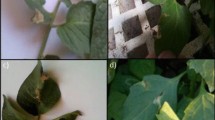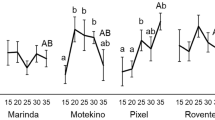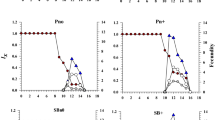Abstract
The tomato leafminer, Tuta absoluta (Meyrick, 1917), is an important pest of tomato in South America, and has been reported in many countries in Europe and the Middle East. The population fluctuation of this species was examined during three consecutive crop years, in a commercial organic greenhouse in southeastern Paraná, subtropical region of Brazil. The T. absoluta abundance was evaluated in the tomato Cordilheira variety during the three crop years, along with TO60 cultivar in the first and Pizzadoro in the last two periods evaluated. Larvae and pupae of T. absoluta were collected; pest threshold levels were not reached in any of the crop years examined. A stepwise multiple regression revealed that minimum and mean temperature were factors that significantly affected the abundance of the tomato leafminer. The peaks of abundance coincided with high previous temperatures. Larval T. absoluta density was highest during the fruiting stage and the abundance was highest on the Cordilheira variety in all seasons and during the three crop years. Four species of parasitoids distributed in three families of the order Hymenoptera were found: Conura sp. Spinola, 1837 (Chalcididae), Earinus sp. Wesmael, 1837 (Braconidae), Myosoma sp. Robertson, 1900 (Braconidae), and Casinaria sp. Holmgren, 1859 (Ichneumonidae). The latter two are cited for the first time parasitizing T. absoluta. Based on the low level of infestation of the species, our findings demonstrate that the lower temperatures prevent T. absoluta from becoming a major pest in the evaluated region, characterized by subtropical climate.


Similar content being viewed by others
References
Abbes K, Harbi A, Chermiti B (2012) The tomato leafminer Tuta absoluta (Meyrick) in Tunisia: current status and management strategies. EPPO Bull 42:226–233. https://doi.org/10.1111/epp.2559
Allache F, Houhou MA, Osmane I, Naili L, Demnati F (2012) Suivi de l’evolution de la population de Tuta absoluta Meyrick (Lepidoptera: Gelechiidae), um nouveau ravageur de la tomate sous serre à Biskra (sud-est d’ Algérie). Entomologie Faunistique – Faunistic Entomol 65:149–155
Alvares CA, Stape JL, Sentelhas PC, Gonçalves JLM, Sparovek G (2014) Köppen’s climate classification map for Brazil. Meteorol Z 22:711–728. https://doi.org/10.1127/0941-2948/2013/0507
Awmack CS, Leather SR (2002) Host plant quality and fecundity in herbivorous insects. Annu Rev Entomol 47:817–844. https://doi.org/10.1146/annurev.ento.47.091201.145300
Bacci L (2006) Fatores determinantes do ataque de Tuta absoluta ao tomateiro. PhD Thesis. Universidade Federal de Viçosa
Bacci L, Silva EM, Silva GA, Silva LJ, Rosado JF, Samuels RI, Picanço MC (2018) Natural mortality factors of tomato leafminer Tuta absoluta in open-field tomato crops in South America. Pest Manag Sci. https://doi.org/10.1002/ps.5173
Bacci L, Silva EM, Martins JC, Soares MA, Campos MR, Picanço MC (2019) Seasonal variation in natural mortality factors of Tuta absoluta (Lepidoptera: Gelechiidae) in open-field tomato cultivation. J Appl Entomol 143:21–23. https://doi.org/10.1111/jen.12567
Balzan MV, Moonen AC (2012) Management strategies for the control of Tuta absoluta (Lepidoptera: Gelechiidae) damage in open-field cultivations of processing tomato in Tuscany (Italy). EPPO Bull 42:217–225. https://doi.org/10.1111/epp.2558
Baniameri V, Cheraghian A (2012) The first report and control strategies of Tuta absoluta in Iran. EPPO Bull 42:322–324. https://doi.org/10.1111/epp.2577
Campos MR, Silva TBM, Silva WM, Silva JE, Siqueira HAA (2015) Spinosyn resistance in the tomato borer Tuta absoluta (Meyrick) (Lepidoptera: Gelechiidae). J Pest Sci 88:405–412. https://doi.org/10.1007/s10340-014-0618-y
Campos MR, Biondi A, Adiga A, Guedes RNC, Desneux N (2017) From the Western Palaeartic region to beyond: Tuta absoluta 10 years after invading Europe. Pest Manag Sci 90:787–796. https://doi.org/10.1007/s10340-017-0867-7
Castelo Branco M (1992) Population dynamics of the tomato leafminer in the Distrito Federal. Hortic Bras 10:33–34
Cocco A, Deliperi S, Delrio G (2013) Control of Tuta absoluta (Meyrick) (Lepidoptera: Gelechiidae) in greenhouse tomato crops usin the mating disruption technique. J Appl Entomol 137:16–28. https://doi.org/10.1111/j.1439-0418.2012.01735.x
Cocco A, Deliperi S, Lentini A, Mannu R, Delrio G (2015) Seasonal phenology of Tuta absoluta (Lepidoptera: Gelechiidae) in protected and open-field crops Mediterranean climatic conditions. Phytoparasitica 43:713–724. https://doi.org/10.1007/s12600-015-0486-x
Coelho MCF, França FH (1987) Biologia, quetotaxia da larva e descrição da pupa e adulto da traça-do-tomateiro. Pesq Agropec Bras 22:129–135
Cornell HV, Hawkins BA (1995) Survival patterns and mortality sources of herbivorous insects: some demographic trends. Am Nat 145:563–593
Cui X, Wan F, Xie M, Liu T (2008) Effects of heat schock on survival and reproduction of two whitefly species, Trialeurodes vaporariorum and Bemisia tabaci biotype B. J Insect Sci 8:25. https://doi.org/10.1673/031.008.2401
Delrio G, Cocco A, Deliperi S (2012) Prospettive e limiti dell’impiego di feromoni sessuali per la lotta contro la tignola del Pomodoro. Atti Accademia Nazionale Italiana di Entomologia LX, pp 103–109
Desneux N, Decourtye A, Delpuech JM (2007) The sublethal effects of pesticides on beneficial arthropods. Annu Rev Entomol 52:81–106. https://doi.org/10.1146/annurev.ento.52.110405.091440
Desneux N, Wajnberg E, Wyckhuys AGK, Burgio G, Arpaia S, Narváez-Vasquez CA, Gonzalez-Cabrera J, Catalan Ruescas D, Tabone E, Frandon J, Pizzol J, Poncet C, Cabello T, Urbaneja A (2010) Biological invasion of European tomato crops by Tuta absoluta: ecology, geographic expansion and prospects for biological control. J Pest Sci 83:197–215. https://doi.org/10.1007/s10340-010-0321-6
Desneux N, Luna MG, Guillemaud T, Urbaneja A (2011) The invasive South American tomato pinworm, Tuta absoluta, continues to spread in Afro-Eurasia and beyond: the new threat to tomato world production. J Pest Sci 84:403–408. https://doi.org/10.1007/s10340-011-0398-6
Draper NR, Smith H (1981) Applied regression analysis. Wiley, New Delhi
Estay SA, Lima M, Labra FA (2009) Predicting insect pest status under climate change scenarios: combining experimental data and population dynamics modeling. J Appl Entomol 133:491–499. https://doi.org/10.1111/j.1439-0418.2008.01380.x
Fernandez S, Montagne A (1990) Biología del minador del tomate, Scrobipalpula absoluta (Meyrick) (Lepidoptera: Gelechiidae). Bol Entomol Venez 5:89–99
França FH, Castelo Branco M (1992) Ocorrência da traça-do-tomateiro (Tuta absoluta) em solanáceas silvestres no Brasil Central. Hortic Bras 10:6–10
Geiger F, Bengtsson J, Berendse FFBN, Weisser WW, Emmerson M, Morales MB et al (2010) Persistent negative effects of pesticides on biodiversity and biological control potential on European farmland. Basic Appl Ecol 11:97–105. https://doi.org/10.1016/j.baae.2009.12.001
Germain JF, Lacordaire AI, Cocquempot C, Ramel JM, Oudard E (2009) A new tomato pest in France: Tuta absoluta. PHM Revue Horticole 512:37–41
Guedes RNC, Picanço MC (2012) The tomato borer Tuta absoluta in South America: pest status, management and insecticide resistance. EPPO Bull 42:211–216. https://doi.org/10.1111/epp.2557
Guedes RNC, Siqueira HAA (2012) The tomato borer Tuta absoluta: insecticide resistance and control failure. CAB Rev Perspect Agric Vet Sci Nutr Nat Resour 7:1–7. https://doi.org/10.1079/PAVSNNR20127055
Haddi K, Berger M, Bielza P, Cifuentes D, Field LM, Gorman K, Rapisarda C, Williamson MS, Bass C (2012) Identification of mutations associated with pyrethroid resistance in the voltage-gated sodium channel of the tomato leaf miner (Tuta absoluta). Insect Biochem Mol Biol 42:506–513. https://doi.org/10.1016/j.ibmb.2012.03.008
Haji FNP, Oliveira CAV, Amorin Neto MS, Batista JGS (1988) Flutuação populacional da traça-do-tomateiro no Submédio São Francisco. Pesq Agropec Bras 23:7–14
Han P, Lavoir AV, Le Bot J, Amiens-Desneux E, Desneux N (2014) Nitrogen and water availability to tomato plants triggers bottom-up effects on the leafminer Tuta absoluta. Sci Rep 4:4455. https://doi.org/10.1038/srep04455
Han P, Bearez P, Adamowicz S, Lavoir A-V, Amiens-Desneux E, Desneux N (2015) Nitrogen and water limitations in tomato plants trigger negative bottom-up effects on the omnivorous predator Macrolophus pygmaeus. J Pest Sci 88:685–691. https://doi.org/10.1007/s10340-015-0662-2
Harbi A, Abbes K, Chermiti B (2012) Evaluation of two methods for the protection of tomato crops against the tomato leaf miner Tuta absoluta (Meyrick) under greenhouses in Tunisia. EPPO Bull 42:317–321. https://doi.org/10.1111/epp.2576
Harrison RG (1980) Dispersal polymorphism in insects. Annu Rev Ecol Syst 11:95–118
Holland JM, Bianchi FJJA, Entling MH, Moonen AC, Smith BM, Jeanneret P (2016) Structure, function and management of semi-natural habitats for conservation biological control: a review of European studies. Pest Manag Sci 72:1638–1651. https://doi.org/10.1002/ps.4318
Kiliç T (2010) First record of Tuta absoluta in Turkey. Phytoparasitica 38:243–244. https://doi.org/10.1007/s12600-010-0095-7
Krechemer FS, Foerster LA (2015) Tuta absoluta (Lepidoptera: Gelechiidae): thermal requirements and effect of temperature on development, survival, reproduction and longevity. Eur J Entomol:112–658, 663. https://doi.org/10.14411/eje.2015.103
Krechemer FS, Foerster LA (2017) Development, reproduction, survival and demographic patterns of Tuta absoluta (Meyrick) (Lepidoptera: Gelechiidae) on different commercial tomato cultivars. Neotrop Entomol 46:694–700. https://doi.org/10.1007/s13744-017-0511-5
Larbat R, Adamowicz S, Robin C, Han P, Desneux N, Le Bot J (2016) Interrelated responses of tomato plants and the leafminer Tuta absoluta to nitrogen supply. Plant Biol 18:495–504. https://doi.org/10.1111/plb.12425
Leather SR (1990) Life history of insect herbivores in relation to host quality. In: Bernays EA (ed) Insect-plant interactions. CRC Press, Florida, pp 175–207
Luna MG, Sánchez NE, Pereyra PC (2007) Parasitism of Tuta absoluta (Lepidoptera: Gelechiidae) by Pseudopanteles dingus (Hymenoptera, Braconidae) under laboratory conditions. Environ Entomol 36:887–893. https://doi.org/10.1590/S0103-84782008000600002
Luna MG, Wada VI, Sánchez NE (2010) Biology of Dineulophus phtorimaeae (Hymenoptera: Eulophidae) and field interaction with Pseudopanteles dignus (Hymenoptera: Braconidae), larval parasitoids of Tuta absoluta (Lepidoptera: Gelechiidae) in tomato. Ann Entomol Soc Am 103:936–942
Mahdi K, Doumandji S (2013) Research on temperature: limiting factor of development of tomato leaf miner Tuta absoluta (Meyrik) (Lepidoptera: Gelechiidae). Int J Agric Sci Res 4:81–88
Mahmoud YA, Ebadah IMA, Abd-Elrazek AS, Abd-Elwahab TE, Masry SHD (2015) Population fluctuation of tomato leaf miner, Tuta absoluta (Meyrick) (Lepidoptera: Gelechiidae) during winter and summer plantations in Egypt. Res J Pharm, Biol Chem Sci 6:647–652
Marchiori CH, Silva CG, Lobo AP (2004) Parasitoids of Tuta absoluta (Meyrick, 1917) (Lepidoptera: Gelechiidae) collected on tomato plants in Lavras, state of Minas Gerais, Brazil. Braz J Biol 64:551–552. https://doi.org/10.1590/S1519-69842004000300018
Marchioro CA, Krechemer FS, Foerster LA (2017) Estimating the development rate of the tomato leaf miner, Tuta absoluta (Lepidoptera: Gelechiidae), using linear and non-linear models. Pest Manag Sci 73:1486–1493. https://doi.org/10.1002/ps.4484
Martins JC, Picanço MC, Bacci L, Guedes RNC, Santana PA Jr, Ferreira DO, Chediak M (2016) Life table determination of thermal requirements of the tomato borer Tuta absoluta. J Pest Sci 89:897–908. https://doi.org/10.1007/s10340-016-0729-8
Martins JC, Picanço MC, Silva RS, Gonring AHR, Galdino TVS, Guedes RNC (2018) Assessing the spatial distribution of Tuta absoluta (Lepidoptera: Gelechiidae) eggs in open-field tomato cultivation through geostatiscal analysis. Pest Manag Sci 74:30–36. https://doi.org/10.1002/ps.4664
Naranjo SE, Ellsworth PC (2005) Mortality dynamics and population regulation in Bemisia tabaci. Entomol Exp Appl 116:93–108. https://doi.org/10.1111/j.1570-7458.2005.00297.x
Nigro RG, Campos MCC, Perondini ALP (2007) Temperature and the progeny sex-ratio in Sciara ocellaris (Diptera, Sciaridae). Genet Mol Biol 30:152–158. https://doi.org/10.1590/S1415-47572007000100026
Novotný V (1994) Relation between temporal persistence of host plants and wing length in leafhoppers (Hemiptera, Auchenorrhyncha). Ecol Entomol 19:168–176
Pereyra PC, Sánchez NE (2006) Effect of two solanaceous plants of development and population parameters of the tomato leaf miner, Tuta absoluta (Meyrick) (Lepidoptera: Gelechiidae). Neotrop Entomol 35:672–675. https://doi.org/10.1590/S1519-566X2006000500016
Roditakis E, Papachristos D, Roditakis NE (2010) Current status of the tomato leafminer Tuta absoluta in Greece. EPPO Bull 40:163–166. https://doi.org/10.1111/j.1365-2338.2009.02367.x
Sánchez NE, Pereyra PC, Luna MG (2009) Spatial patterns o parasitismo of the solitary parasitoid Pseudopanteles dignus (Hymenoptera: Braconidae) on Tuta absoluta (Lepidoptera: Gelechiidae). Environ Entomol 38:365–374
Silva GA, Picanço MC, Bacci L, Crespo ALB, Rosado JF, Guedes RNC (2011) Control failure likelihood and spatial dependence of insecticide resistance in the tomato pinworm, Tuta absoluta. Pest Manag Sci 67:913–920. https://doi.org/10.1002/ps.2131
Silva JE, Assis CPO, Ribeiro LMS, Siqueira HAA (2016) Field-evolved resistance and cross-resistance of Brazilian Tuta absoluta (Lepidoptera: Gelechiidae) populations to diamide insecticides. J Econ Entomol 109:2190–2195. https://doi.org/10.1093/jee/tow161
Siqueira HAA, Guedes RNC, Picanço MC (2000) Insecticide resistance in populations of Tuta absoluta (Lepidoptera: Gelechiidae). Agric For Entomol 2:147–153. https://doi.org/10.1046/j.1461-9563.2000.00062.x
Siqueira HAA, Guedes RNC, Fragoso DB, Magalhães LC (2001) Abamectin resistance and synergism in brazilian populations of Tuta absoluta (Meyrick) (Lepidoptera: Gelechiidae). Int J Pest Manage 47:247–251. https://doi.org/10.1080/09670870110044634
Spiegel LH, Price PW (1996) Plant aging and the distribution of Rhyacionia neomexicana (Lepidoptera: Tortricidae). Environ Entomol 25:359–365
Statsoft Inc (2007) Statistica for Windows: Statsoft Inc., Tulsa
Taha AM, Afsah AFE, Fargalla FH (2013) Evaluation of the effect of integrated control of tomato leafminer Tuta absoluta with sex pheromone and insecticides. Nat Sci 11:26–29
Thomson LJ, Hoffmann AA (2009) Vegetation increases the abundance of natural enemies in vineyards. Biol Control 45:259–269. https://doi.org/10.1016/j.biocontrol.2009.01.009
Uchôa-Fernandes MA, Della Lucia TMC, Vilela EF (1995) Mating, oviposition and pupation of Scrobipalpuloides absoluta (Meyr.) (Lepidoptera: Gelechiidae). An Soc Entomol Bras 24:159–164
Urbaneja A, González-Cabrera J, Arnó J, Gabarra R (2012) Prospects for the biological control of Tuta absoluta in tomatoes of the Mediterranean basin. Pest Manag Sci 68:1215–1222. https://doi.org/10.1002/ps.3344
Van Damme V, Berkvens N, Moerkens R, Berckmoes E, Wittemans L, De Vis R, Casteels H, Tirry L, De Clercq P (2015) Overwintering potential of the invasive leafminer Tuta absoluta (Meyrick) (Lepidoptera: Gelechiidae) as a pest in greenhouse tomato production in Western Europe. J Pest Sci 88:533–541. https://doi.org/10.1007/s10340-014-0636-9
van der Blom J, Robledo A, Torres S, Sánchez JA (2009) Consequences of the wide scale implementation of biological control in greenhouse horticulture in Almeria, Spain. IOBC/WPRS Bull 49:9–13
Viggiani G, Filella F, Delrio G, Ramassini W, Foxi C (2009) Tuta absoluta, a new Lepidoptera now reported in Italy. Inf Agrar 65:66–68
Wallner WE (1987) Factors affecting insect population dynamics: differences between outbreak and non-outbreak species. Annu Rev Entomol 32:317–340
Waltz AM, Whitham TG (1997) Plant development affects arthropod communities: opposing impacts of species removal. Ecology 78:2133–2144
Wolda H (1988) Insect seasonality: why? Annu Rev Ecol Syst 19:1–18
Acknowledgements
The authors thank the Brazilian National Research Council (CNPq) for scholarship and financial support, Dr. Maria Christina de Almeida and Dr. Bolívar Rafael Garcete Barrett for the identification of larval parasitoids, Mr. Massatoshi Shiono and Mrs. Sumako Shiono by allowing the study to be carried out in their property and Dr. Carla Pedroso de Moraes for help in the field work.
Funding
This study was funded by Brazilian National Research Council (CNPq) with scholarship (grant number 140548/2010–6).
Author information
Authors and Affiliations
Contributions
FSK and LA conceived and designed the research. FSK obtained the data and conducted data analyses. FSK and LA wrote the manuscript. All authors read and approved the manuscript.
Corresponding author
Ethics declarations
Conflict of interest
The author Flavia da Silva Krechemer has received scholarship from Brazilian National Research Council (CNPq).
Additional information
Publisher’s note
Springer Nature remains neutral with regard to jurisdictional claims in published maps and institutional affiliations.
Rights and permissions
About this article
Cite this article
da Silva Krechemer, F., Foerster, L.A. Influence of biotic and abiotic factors on the population fluctuation of Tuta absoluta (Lepidoptera: Gelechiidae) in an organic tomato farming. Int J Trop Insect Sci 40, 199–208 (2020). https://doi.org/10.1007/s42690-019-00070-1
Received:
Accepted:
Published:
Issue Date:
DOI: https://doi.org/10.1007/s42690-019-00070-1




